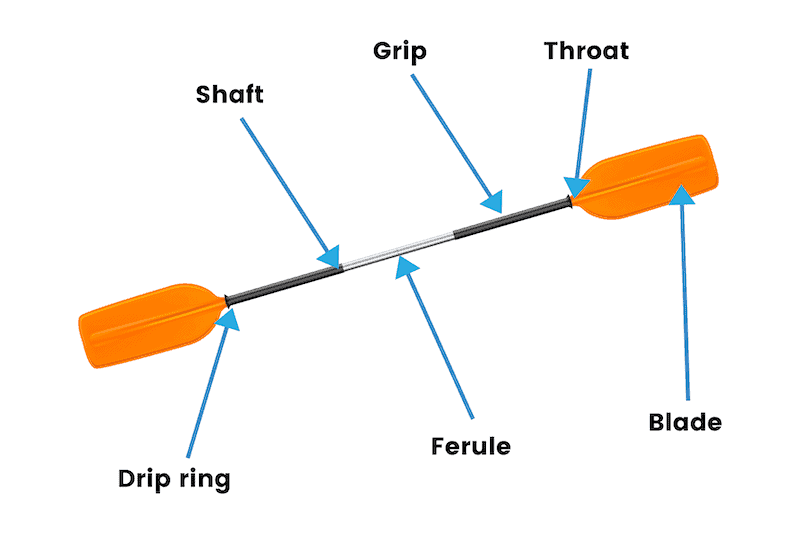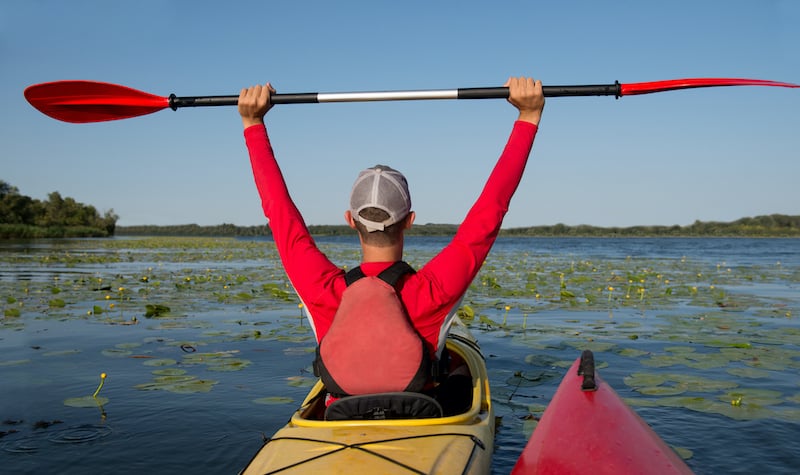For beginners, properly holding the kayak paddle can make all of the difference in their paddling adventure. Using the wrong grip can make you tired quickly and leave you with sore muscles. No matter what type of paddling you do, picking the right paddle and using it properly is the first step to having fun on the water.
In this post, we’re going to walk you through our how to hold a kayak paddle correctly guide for beginners so that you can paddle for longer and not ache as much the following day. Let’s get started.
Types of Kayak Paddle

Before we get to exactly how to hold your paddle, it’s worth mentioning that there are lots of different types of paddles used for kayaking. Kayak paddles have a blade on each side of a central shaft. Some beginner or rental paddles are flat and completely symmetrical, but most paddles use blades that have a cupped shape. Most paddles break apart into two pieces, but some are one solid piece. Paddles can be made from aluminum, plastic, fiberglass, carbon fiber, or a combination of materials. In general, the best kayak paddles are the lightest ones you can afford. A nice, lightweight paddle is the single best investment you can make towards enjoying your kayaking adventures more.
If the two blades are aligned with one another, it is a matched paddle. Feathered paddles have one blade offset from the other, and the orientation of the blades is different for right-handed or left-handed paddlers. If the paddle has a break-apart two-piece design, it can usually be set to be either matched or feathered.
While most paddles have straight shafts, some have bent shafts that reduce the angles your wrists make during the power stroke. These look odd but are pretty comfortable to use once you get the hang of it.
The shapes of the blades vary significantly from one paddle design to another. Most are asymmetrical, meaning that their upper edge is longer than their bottom. They also are cupped to get more power as they are pulled through the water.
Paddle Sizing
The right size kayak paddle for you depends on two factors. First, you need to get a paddle that is appropriate for your size. Taller people have a greater distance between their shoulders and elbows, so they need a longer paddle. You also need to make sure that your paddle is long enough to clear the sides of your kayak without you having to twist your waist awkwardly. Kayak paddle shafts are measured in centimeters.
Most kayak paddle makers provide a very accurate sizing chart. Be sure to check it carefully to get the right one for you. It will usually be based on your height or your torso length.
Paddle shafts also come in different diameters. This is important for people with small hands since holding a standard width shaft for extended periods may cause undue fatigue.
Holding a Kayak Paddle the Right Way

Step 1: Hold the Paddle Correctly
Make sure you’re holding the paddle in the correct orientation. Study the paddle that you’re using. Most paddles have two features that will give away how you are supposed to hold them. First, the blades are likely asymmetrical, with a long edge and a short edge. This design allows for more power during your stroke. Make sure that the long edge is pointed up.
The paddle blades are also usually cupped. Like you cup your hands when swimming to get a better bite in the water, the paddle blade is cupped to make more power. And just like a swimmer’s cupped hands, you should point the cups into the water you’re pushing on. In this case, the cups point towards the back of the boat.
Of course, there are some paddle blades that are completely flat and symmetrical. If that’s the case, don’t sweat it. It probably doesn’t matter which way you hold it!
Step 2: Where and How to Grip the Paddle

The key to holding a kayak paddle is to remember that it should be comfortable. If your arms are held out at a funny angle, or you’re white-knuckling the paddle with all your might, you probably aren’t as comfortable as you should be.
Start with your arms hanging comfortably at your sides and bend your elbows up. Hold the paddle with your hands slightly wider apart than your shoulders, or at about the same distance as your elbows are apart. If you have a wider boat, you might need to adjust your hands a little farther apart. Then make sure that you are holding the paddle roughly centered, with both blades approximately the same distance from your hands.
Also, make sure you aren’t gripping the paddle too tightly. When you pull yourself through the water, it’s your torso and waist that should be making the power. The less you move your arms, the better. The paddle should be an extension of your arm. The weight is balanced between your two hands, and it shouldn’t take any significant effort to move it.
All of these tips are aimed at reducing fatigue. When you start, you’ll likely do shorter paddling trips. As you build experience and become more comfortable, you’ll find little things that will help you.
Step 3: Using a Feathered Paddle
If your paddle breaks apart and has the option to be set up as a matched paddle with the blades parallel, you should start with that. Once you have the basics down, it’s then easier to transition to using a feathered paddle.
The basic idea of using a feathered paddle is that one of your hands will remain fixed on the paddle while the other moves. What’s the advantage of feathering the blades? It’s primarily used by racers and performance paddlers who want to reduce the upward blade’s wind resistance. For recreational and touring kayakers, the difference in wind resistance is usually negligible.
But some folks just like the feel and handling of using a feathered paddle. Once you have the basics down with a matched paddle, switch to a feathered one and see how you like it. You may find that it takes a few minutes to smooth out your stroke, but it feels very natural and balanced once you get used to it.
Conclusion
Now that you know a little more about kayak paddles and how to hold them, you’re ready to hit the water. Don’t be intimidated by all of the different paddle designs and strokes—the critical thing is to get out on the water and give it a whirl. You don’t have to be an expert to move the boat, but correctly holding the paddle lays the groundwork for a lifetime of fun trips on the water.
Once you’ve got the hang of how to hold your paddle you can start learning the proper paddling technique and level up your skills.
